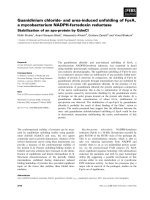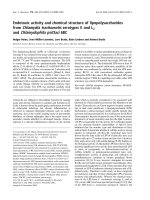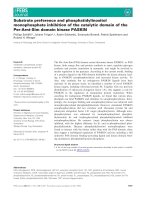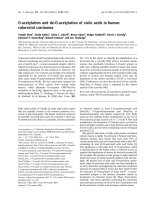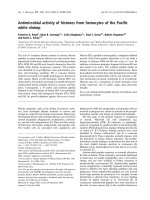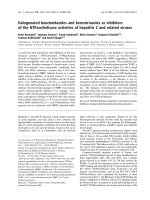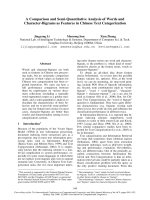BÀI báo KHOA học ANTIMICROBIAL ACTIVITY AND PHOSPHORUS RELEASE BEHAVIOR OF STARCH OR CHITOSAN HYDROGEL MEMBRANES
Bạn đang xem bản rút gọn của tài liệu. Xem và tải ngay bản đầy đủ của tài liệu tại đây (185.22 KB, 10 trang )
ANTIMICROBIAL ACTIVITY AND PHOSPHORUS RELEASE BEHAVIOR OF
STARCH/CHITOSAN HYDROGEL MEMBRANES
LE THI PHUONG , TRAN NGOC QUYEN, DUONG THI BE THI, NGUYEN CUU KHOA
*
SUMMARY
The use of slow release fertilizer has become a new trend to improve fertilize use efficiency and
to minimize environmental pollution. In this paper, we investigated the phosphorus release
behavior of controlled-release fertilizer (CRF) hydrogels, which were prepared from
starch/chitosan, using formaldehyde as a crosslinker. The antimicrobial activities of these
membranes were also investigated. It was found that, these membranes showed fair activity
against E.coli, Aspergillus niger and F.oxysporum. Therefore such membranes can be used to
prolong shelf life of CRF in preservation.
1. INTRODUCTION
The growth of plants and their quality are mainly a function of the quantity of fertilizer and
water. So it is very important to improve the utilization of water resources and fertilizer
nutrients. However, about 40–70% of nitrogen, 80–90% of phosphorus, and 50–70% of
potassium of the applied normal fertilizers is lost to the environment and cannot be absorbed by
plants, which causes not only large economic and resource losses but also very serious
environmental pollution [1-5]. Controlled release is a method used to solve this problem
Chitosan (poly-β(1,4)-d-glucosamine), a cationic polysaccharide, is obtained by alkaline
deacetylation of chitin, the principal exoskeletal component in crustaceans. As the combination
of properties of chitosan such as water binding capacity, fat binding capacity, bioactivity,
biodegradability, nontoxicity, biocompatibility, and antifungal activity, chitosan and its modified
analogs have shown many applications in medicine, cosmetics, agriculture, biochemical
separation systems, tissue engineering, biomaterials and drug controlled release systems [6-12].
Although chitosan has been shown to have excellent biodegradability, it has a lower swelling
ability when it forms hydrogel due to the slower relaxation rate of polymer chains [13].
Therefore, blending chitosan with other hydrophilic polymers improve its water absorbency at
gel state. Jen Ming Yang et al. have reported about chitosan/PVA blended hydrogel membranes
[14]. Although the thermo stability of the chitosan/PVA blended hydrogel membrane is
enhanced and the values of water content, water vapor transmission and permeability of solutes
such as creati-nine, 5-FU and vitamin B12 through chitosan/PVA blended hydrogel membranes
increase linearly with chitosan content, chitosan and PVA are not very compatible in the
chitosan/PVA blended hydrogel membrane. In addition, PVA is difficult to be degraded in
natural environment.
Starch is a polysaccharide derived from plants that can be produced at low cost and large
scale. Starch is abundant, edible, fully biodegradable, easily renewable, a low cost and a
promising candidate for developing sustainable materials. Recently, many researchers have
extensively explored the development of starch composite films with other polymers such as
collagen, poly (vinyl alcohol), carrageenan, gelatin, lignin, chitosan.
In this study, starch/chitosan blended hydrogel membranes were prepared using
formaldehyde as chemical crosslinking agent. We investigated the influence of CS on the
antibacterial activity of these membranes and the phosphorus release behavior of CRF hydrogels.
2. EXPERIMENTAL
2.1. Materials.
The biopolymers used in the experiments are commercial starch and chitosan. Chitosan ( M
w
=
100,000-300,000) and a degree of deacetylation of 75-85%, was obtained from Acros, USA.
Formaldehyde 37%, Calcium dihydrophosphate (Ca(H
2
PO
4
)
2
)was purchased from Guangdong,
China
2.2. Preparation of starch/CS blended hydrogel membranes
The starch/CS blended hydrogel membranes were prepared by mixing 10%w/v starch solution
with different amount of formaldehyde from 5-30%wt. formaldehyde, based on the total dry
weight of polyme at 60-65
0
C for 40 minutes, the pH was raised to 8-9 by 10%w/v NaOH. The
temperature of solution was got down 40
0
C and the pH was adjusted to 5 by 10% HCl. Then the
solution was mixed with 2,67%w/v chitosan solution at a ratio 1:1 by weight and stirred
constantly until homogeneous. After mixing, the gel was formed within 30 minutes. The product
was dried at 60
0
C
in a vacuum oven overnight.
2.3. Preparation of CRF hydrogels
The CRF starch/CS hydrogel was prepared by the following method. Starch solution was mixed
with chitosan solution at a ratio 1:1 by weight, treated with 20%wt. formaldehyde. The mixture
was stirred constantly until homogeneous and the appropriate amount of Ca(H
2
PO
4
)
2
fertilizer
was added into the mixture under constant stirring. After mixing, the gel was formed within 30
minutes. The CRF hydrogel product was dried at 60
0
C
in a vacuum oven overnight. The amount
of starch, CS, formaldehyde, fertilizer used for preparing the CRF hydrogels, are shown in Table
1.
Table 1: Formulation of CRF hydrogels
CRF hydrogels 10%w/v Starch
(ml)
2,67%w/v CS
(ml)
Fertilizer (g) 37% formaldehyde
solution (ml)
CS1 15 15 0,5 0,34
CS2 15 15 1 0,34
CS3 15 15 2 0,34
CS4 15 15 3 0,34
2.4. Characterizations
Structure of starch/CS blended hydrogel was analyzed using Fourier-transform infrared (FTIR)
spectrophotometer (Equinox 55 Bruker)
2.5. Water Absorbency of CRF Hydrogels
A preweighed dry hydrogel sample was immersed into a certain amount of deionized water. At
certain time intervals the hydrogel was taken out of the water. Excessive surface water of the
swollen hydrogel was removed with a filter paper, and the weight of the swollen sample was
measured. Swelling ratio (%SR) of the hydrogel was calculated using the equation:
100% ×
−
=
d
ds
W
WW
SR
where W
s
and W
d
refer to the weight of swollen and dry hydrogels, respectively.
2.6. Antimicrobial assessment
Eight strains of microorganisms were used to test the antimicrobial activity of membranes,
including: Escherichia coli, Pseudomonas aeruginosa (Gram-negative bacteria); Staphylococcus
aureus, Bacillus subtillis (Gram-negative bacteria); Aspergillus niger, Fusarium oxysporum
(fungus) ; Candida albicans, Saccharomyces cerevisiae (yeast). Antimicrobial activity of
prepared membranes was assayed by Vander Bergher and Vlietlinck method (1991), performed
using a sterile 96 well-microplate. The bacteria were cultured in Trypcase Soya Broth (TSB),
while yeast/fungus was cultured in Saboraud Dextrose Broth (SDB) and incubated at 37
0
C for
24 hours. Then, the active cultures were inoculated into 10 ml of TSB for bacteria and SDB for
yeast/fungus and incubated at 37
0
C/24 hours (bacteria) or 37
0
C/48 hours (yeast/fungus).
Antimicrobial activity of hydrogel was recorded in terms of MIC, which was defined as the
lowest concentration of sample required to completely inhibit microbial growth.
2.7. Encapsulation Efficiency Analysis
To study encapsulation efficiency of fertilizer in the CRF hydrogels, a CRF hydrogel sample was
immersed into a certain amount of deionized water for 1 min and then kept
aliquot solution was sampled for P determination, assayed to determine the concentration of the
unencapsulated fertilizer. Encapsulation efficiency (%) was calculated by the
following formula :
%Encapsulation efficiency = [1- Unencapsulated fertilizer/Total fertilizer]x100
2.8. Release Behavior in Water
The release behaviors of phosphorus from the CRF hydrogels in deionized water were
investigated by UV-visible spectrophotometry (UV-1800 Shimadzw). A 5.00 mL fertilizer
sample solution was pipette into a 25.00 mL volumetric flask, then, 5.00 mL of
molybdovanadate reagent was added. Deionized water was also added to make a 25.00 mL
solution. After 30 minutes, at the room temperature. The absorbance of the sample solution was
measured at a wavelength of 420 nm by UV spectrophotometer. The amount of phosphorrus in
the sample solution was calculated using the calibration curve. [15].
3. RESULTS AND DISCUSSION
3.1. Characterization of Hydrogels by FTIR
H
C
O
H
base
H
2
C
OH
OSt
H
Chitosan
H
2
C
O
O
N Chitosan
H
Starch
Starch
OH
Scheme 1. Crosslinking reaction of chitosan and starch with formaldehyde
Fig.1. FT–IR spectra of (a) chitosan, (b) starch and (c)starch/chitosan hydrogel crosslinked
with formaldehyde.
The IR spectra of starch/CS hydrogel (Fig. 1)show peaks as following. Two picks found around
1664 and 1648 cm
-1
, indicating the formation of imine bond (C=N) via Schiff’s base structure by
the reactions between amino groups of chitosan and aldehyde groups of formaldehyde. And a
strong absorption at peak 1160 cm
-1
was found, relating to C–O–C groups, indicating a formation
of acetal bridges
3.2. Antimicrobial activity of starch/CS hydrogel membrane
Table 2: Antimicrobial activity of hydrogel membrane
Hydrogel
membrane
MIC (µg/ml)
Gram-negative
bacteria
Gram-positive
bacteria
Fungus Yesat
E.
coli
P.
aeruginosa
B.
subtillis
S.
aureus
A.
niger
F.
oxysporum
S.
cerevisiae
C.
albicans
Starch
hydrogel
(-) (-) (-) (-) (-) (-) (-) (-)
Starch/CS
hydrogel
25 (-) (-) (-) 50 50 (-) (-)
C=N
C-O-C
a
b
c
N-H
C-O-C
C-H
O-H
As shown in Table 2, only starch/CS hydrogel membranes exhibited inhibition against test
microorganisms, such as E.coli, A.niger and F.oxysporum. It’s dued to the strong antifungal and
antibacterial of chitosan. Among these microorganisms, E. coli appeared to be most susceptible
to hydrogels, which showed the lowest MIC value or highest inhibitory effect.
3.3. Swelling behaviour of hydrogels
The strength and water preservation efficiency of hydrogel is greatly affected by the amount of
crosslinking agent. The linear structure of chitosan molecule can be transformed into network
structure through crosslinking and water molecule can be preserved in this structure. With the
same ratio of starch and CS, the hydrogels exhibited different swelling ratio with different
amount of formaldehyde. As shown in figures 2 the swelling ratio of hydrogel was highest when
the amount of formaldehyde was 0,34ml (equal to 20%wt. formaldehyde, based on the total dry
weight of polymer). But in the case of excessive amount of crosslinking agent, the lower
swelling ratio appeared. It could be explained that the degree of crosslinking was higher,
resulting in the decrease of network volume for water preservation efficiency of the hydrogel.
Similar results have been reported in literature (Wu et al 2001; Lin-Gibson et al 2003). In case
of 20%wt. formaldehyde, amount of crosslinking agent was neither low nor high; therefore, it
had highest water preservation efficiency.
Fig. 2: Swelling ratio (%) of hydrogels with varying amounts of crosslinking agent.
Fig. 3: Swelling ratio (%) of starch/CS hydrogel (treated with 0,34ml formaldehyde)
The swelling ratio of hydrogel after 60 days is shown in Fig. 3. The hydrogel exhibited high
initial swelling rates and then the rate become constant after 5 days. It can also be seen from the
figure that, at equilibrium, hydrogel showed the highest water absorbency (≈310 %) on the 30
th
day. With this high swelling ratio, phosphorus would diffuse out of the CRF hydrogels more
easily. Therefore, we can controll the phosphorus release behaviors of the CRF hydrogels
superiorly
3.4. Encapsulation Efficiency Analysis
It was found that the CS1, CS2, CS3, CS4 hydrogels show the highest encapsulation efficiency
values of 76,58%; 75,3%; 72,2% và 70,07%, respectively.
3.5. Release Behavior in Water
Fig.4: Release behaviors of phosphorus in water of hydrogel.
The phosphorus release behavior of the CRF hydrogel in the deionized water at the room
temperature was shown in Figure 3. The release rate of the CRF hydrogel was high initially and
became constant after 3–6 days. It was due to the high concentration difference between the
inside structure of the CRF hydrogel and the outer solution at the beginning of the release period.
Then, the phosphorus release rate decreased as the concentration difference decreased. The result
was in good agreement with the results reported by Rui et al. [16].
4. CONCLUSIONS
Controlled release fertilizer (CRF) hydrogels prepared form starch/CS hydrogels exhibited high
swelling ratio (≈300% after 10 days). This is one of the most important properties of the CRF
hydrogels for their applications in agriculture, for the water absorption during raining or
irrigating. The release behavior of phosphorus from the CRF hydrogels in deionized water was
also investigated. The percent phosphorus cumulative release on the 15
th
day was 62,85%. With
the increasing chitosan solution concentration, the antimicrobial activity of CRF hydrogels
increased, especially E.coli. This could prolong the shelf life of CRF because these
microorganisms could produce enzyme degraded starch structure. Further studies to produce
different controlled-release fertilizer concerned with different plants.
REFERENCES
1. Behera S. K., Panda R. K.: Integrated management of irrigation water and fertilizers for wheat
crop using field experiments and simulation modeling. Agricultural Water Management, 96,
1532–1540 (2009).
2. Mandal K. G., Hati K. M., Misra A. K.: Biomass yield and energy analysis of soybean
production in relation to fertilizer-NPK and organic manure. Biomass and Bioenergy, 33, 1670–
1679 (2009).
3. Gu Y. F., Zhang Z. P., Tu S. H., Lindström K.: Soil microbial biomass, crop yields, and
bacterial community structure as affected by long-term fertilizer treatments under wheat-rice
cropping. European Journal of Soil Biology, 45, 239–246 (2009).
4. Trenkel M. E.: Controlled-release and stabilized fertilizers in agriculture. International
Fertilizer Industry Association, Paris (1997).
5. Saigusa M.: Broadcast application versus band application of polyolefin-coated fertilizer on
green peppers grown on andisol. Journal of Plant Nutrition, 23,
1485–1493 (2000).
6. J. Ge, Y. Cui, Y. Yan, W. Jiang, The effect of structure on pervaporation of chitosan
membrane, J. Membr. Sci. 165 (2000) 75–81.
7. D. Knorr, Dye binding properties of chitin and chitosan, J. Food Sci. 48 (1983) 36–41.
8. D.K. Kweon, S.B. Song, Y.Y. Park, Preparation of water-soluble chitosan/heparin complex
and its application as wound healing accelerator, Biomaterials 24 (2003) 1595–1601.
9. Y. Hu, X. Jiang, Y. Ding, H. Ge, Y. Yuan, C. Yang, Synthesis and characterization of
chitosan-poly(acrylic acid) nanoparticles, Biomaterials 23 (2002) 3193–3201.
10. M. Ishihara, K. Nakanishi, K. Ono, M. Sato, M. Kikuchi, Y. Saito, H.Yura, T. Matsui, H.
Hattori, M. Uenoyama, A. Kurita, Photocrosslinkable chitosan as dressing for wound occlusion
and accelerator in healing process, Biomaterials 23 (2002) 833–840.
11. X.Y. Shi, T.W. Tan, Preparation of chitosan/ethylcellulose complex microcapsule and its
application in controlled release of vitamin D2, Biomaterials 23 (2002) 4469–4473.
12. S.J.K. Francis, H.W.T. Matthew, Application of chitosan-based polysaccharide biomaterials
in cartilage tissue engineering: a review, Biomaterials 21 (2000) 2589–2598.
13. Mi FW, Kuan CY, Shyu SS, Lee ST, Chang SF (2000) Carbohydrate Polymer 41:389
14. Jen Ming Yang, Wen Yu Su, Te Lang Leu , Ming Chien Yang (2004), Evaluation of
chitosan/PVA blended hydrogel membranes
15. AOAC. (1990). Official Methods of Analysis (15
th
ed.). Washington, DC, USA: Association
of Analytical Chemistry.
16. Rui L, Mingzhu L, Lan W (2007) React Funct Polym 67:769

